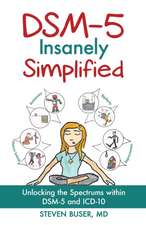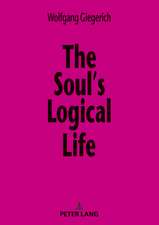Working With Dreams: Initiation into the Soul’s Speaking About Itself
Autor Wolfgang Giegerichen Limba Engleză Paperback – 30 noi 2020
This book is about the practice of working with dreams. Rather than presenting a general theory about dreams, it focuses on the dream as phenomenon and raises the question how we must look at dreams if our approach is supposed to be a truly psychological one. So far most essays on, and the practice of, Jungian dream interpretation have paradoxically centered around the person of the dreamer and not around the dream itself. Dreams were used as a means to understand the analysand and what is going on in him or her. Jung's fundamental shift from his earlier person-based psychology and pre-alchemy stance to his mature soul-based psychology, informed by the hermetic logic of alchemy, has not been followed, which was already noted by Jung himself: My later and more important work (as it seems to me) is still left untouched in its primordial obscurity.
The present study is based decidedly on the stance of mature Jung and his very different views about dreams. His most crucial insights in this regard include that in dreams the soul speaks about itself (not about the dreamer), that the dream is its own interpretation and therefore needs to be circumambulated (rather than translated into the language of psychology and everyday life), and that dream images have everything they need within themselves (rather than needing associations from the dreamerʼs daily life). This book discusses in detail what all this means in practice and what it demands of the psychologist. A decisive transposition away from ordinary consciousness, a crossing to the other side of the river, is required of the consciousness that wants to approach dreams psychologically. Numerous aspects of dreams and special questions that come up in working with dreams are discussed. At the end of this book our working with dreams is situated in the wider question of the psychological task in general by exploring Jungʼs insistence that psychology has to transcend the consulting room, Hillman's move From mirror to window and, in Plato's parable, the revolutionary move out of, and return to, the cave.
While limited to the topic of dreams this book may also serve as an indirect introduction to an understanding of psychology as a psychology with soul (Jung) or as the discipline of interiority.
| Toate formatele și edițiile | Preț | Express |
|---|---|---|
| Paperback (1) | 231.32 lei 6-8 săpt. | |
| Taylor & Francis – 30 noi 2020 | 231.32 lei 6-8 săpt. | |
| Hardback (1) | 1097.61 lei 6-8 săpt. | |
| Taylor & Francis – 30 noi 2020 | 1097.61 lei 6-8 săpt. |
Preț: 231.32 lei
Preț vechi: 243.48 lei
-5% Nou
44.26€ • 46.21$ • 36.63£
Carte tipărită la comandă
Livrare economică 05-19 aprilie
Specificații
ISBN-10: 0367525135
Pagini: 234
Dimensiuni: 156 x 234 x 17 mm
Greutate: 0.23 kg
Ediția:1
Editura: Taylor & Francis
Colecția Routledge
Locul publicării:Oxford, United Kingdom
Public țintă
Postgraduate, Professional, and Professional Practice & DevelopmentCuprins
The dream as a conscious phenomenon. The dream as text
Ontological rupture
The dream as interpretation
"Ontology" of the dream-internal world
1. The seeing of a dream.
2. Mutability and malleability.
3. Shadowiness.
4. Lacunality.
5. ‘Just in time’ apparition, not substantial being.
6. Concepts cloaked in sensible shapes.
II. Why Dreams?
The significance of dreams in therapy
a) The soul’s speaking.
b) "I do not know the answer either."
c) Dreams versus sandplay and painting.
d) Listening to patients’ stories as if they were dreams?
When patients don’t dream
III. The proper attitude towards the dream
Crossing the river. The standpoint of soul
The three stances to "crossing the river" and the three forms of otherness
Psychotherapy—the making of psychology
The dream as corpse.
Not knowing as methodological starting point
The necessity of my going under
IV. The dream interpreter
Whom does the therapist address when working on dreams with a patient?
Who in the therapist interprets the dream?
My interpretation.
The Now of dream interpretation
V. Interpreting the actual text of dreams
"Object level", "subject level" and the objective psyche
Trap: Dream interpretation as the dream’s translation into the terms of one’s psychological theory
Getting started: Beginning with the subject. Circumambulating the dream
Turning to the "object": The dream as subject and self
Inner infinity and the wildness of the living image
Actually working with dreams
Discerning the proper horizon of and context for individual dream elements
Narcissistic blow: "It has a say now, not you!" Or: The patient as obstacle
The dream-I
The dream-I and the Other
1. Necessary distinctions and decisions.
2. The antagonists.
3. The soul’s via negativa.
4. How to view the ego defenses in dreams.
5. Opposition as obvious conflict between Two and the dialectic of successful flight.
6. Opposition as the dream-I’s malgré lui doing the other’s bidding.
Information Classification: General
7. Opposition as antithetical meaning of one and the same.
8. Opposition as impugning the known truth.
Psychic and biological processes in dreams
Semantic content versus syntactic structure
VI. By way of one example: A dream and its psychological interpretation
VII. The dream and the patient
The therapy situation as impairment of dream interpretation.
Absolute-negative interiorization of the patient into the dream
"So the dream shows me that. And now?"
Terrible dream images, unbearable for the patient?
VIII. Miscellaneous questions
The types and topics of dreams
Does the dream have a message for us?
Archetypal dream motifs. Numinous, religious dreams?
Whose dream is it?
"Big" dreams
The dream series
Excursus: Can one learn to interpret dreams?
IX. The ulterior purpose of and assignment for dream interpretation: From Natura to Ars
X. Beyond working with dreams
Pushing off to the dimension of the soul’s real life
Notă biografică
Descriere
This book is about the practice of working with dreams. Rather than presenting a general theory about dreams, it focuses on the dream as phenomenon and raises the question how we must look at dreams if our approach is supposed to be a truly psychological one. So far most essays on, and the practice of, Jungian dream interpretation have paradoxically centered around the person of the dreamer and not around the dream itself. Dreams were used as a means to understand the analysand and what is going on in him or her. Jung's fundamental shift from his earlier person-based psychology and pre-alchemy stance to his mature soul-based psychology, informed by the hermetic logic of alchemy, has not been followed, which was already noted by Jung himself: My later and more important work (as it seems to me) is still left untouched in its primordial obscurity.
The present study is based decidedly on the stance of mature Jung and his very different views about dreams. His most crucial insights in this regard include that in dreams the soul speaks about itself (not about the dreamer), that the dream is its own interpretation and therefore needs to be circumambulated (rather than translated into the language of psychology and everyday life), and that dream images have everything they need within themselves (rather than needing associations from the dreamerʼs daily life). This book discusses in detail what all this means in practice and what it demands of the psychologist. A decisive transposition away from ordinary consciousness, a crossing to the other side of the river, is required of the consciousness that wants to approach dreams psychologically. Numerous aspects of dreams and special questions that come up in working with dreams are discussed. At the end of this book our working with dreams is situated in the wider question of the psychological task in general by exploring Jungʼs insistence that psychology has to transcend the consulting room, Hillman's move From mirror to window and, in Plato's parable, the revolutionary move out of, and return to, the cave.
While limited to the topic of dreams this book may also serve as an indirect introduction to an understanding of psychology as a psychology with soul (Jung) or as the discipline of interiority.



















